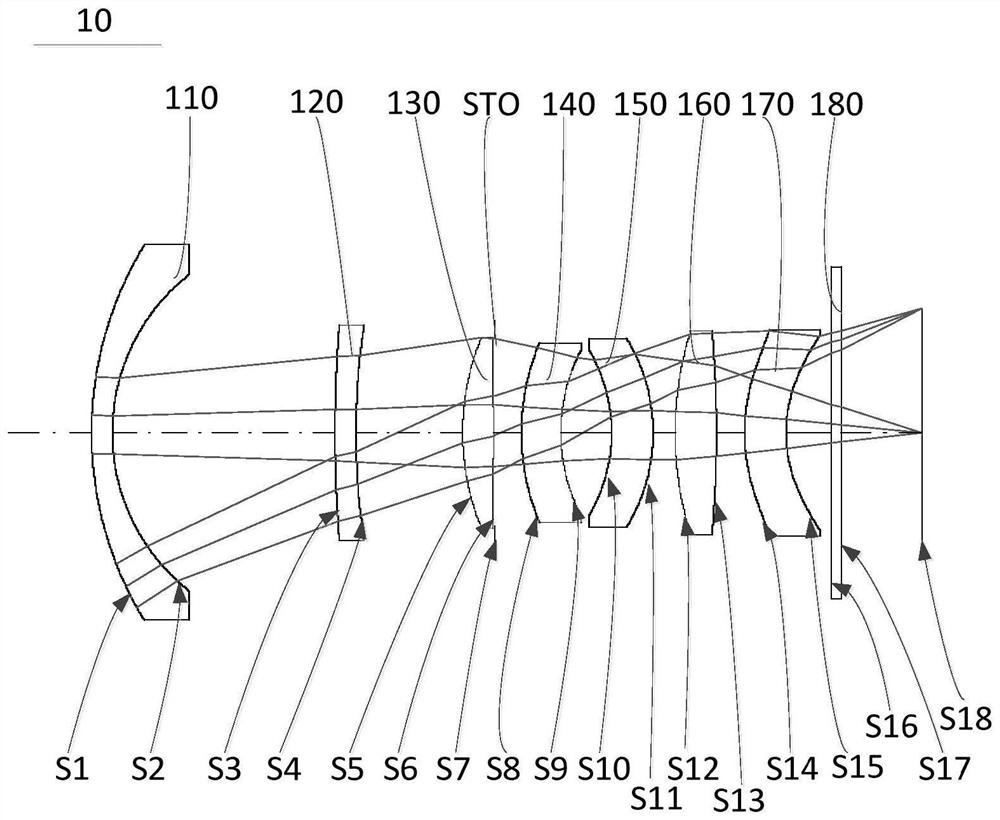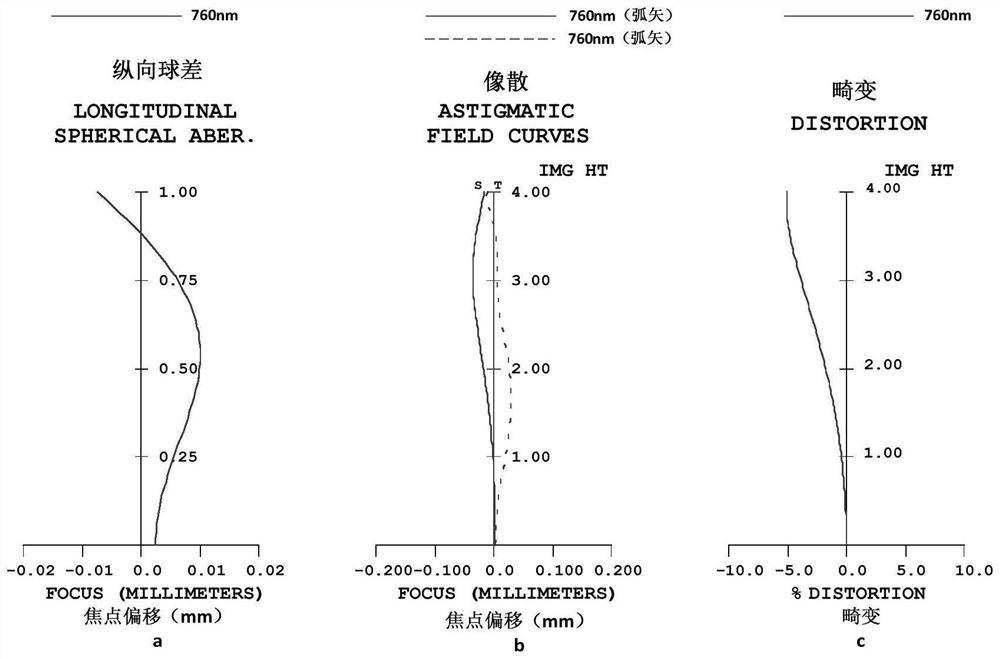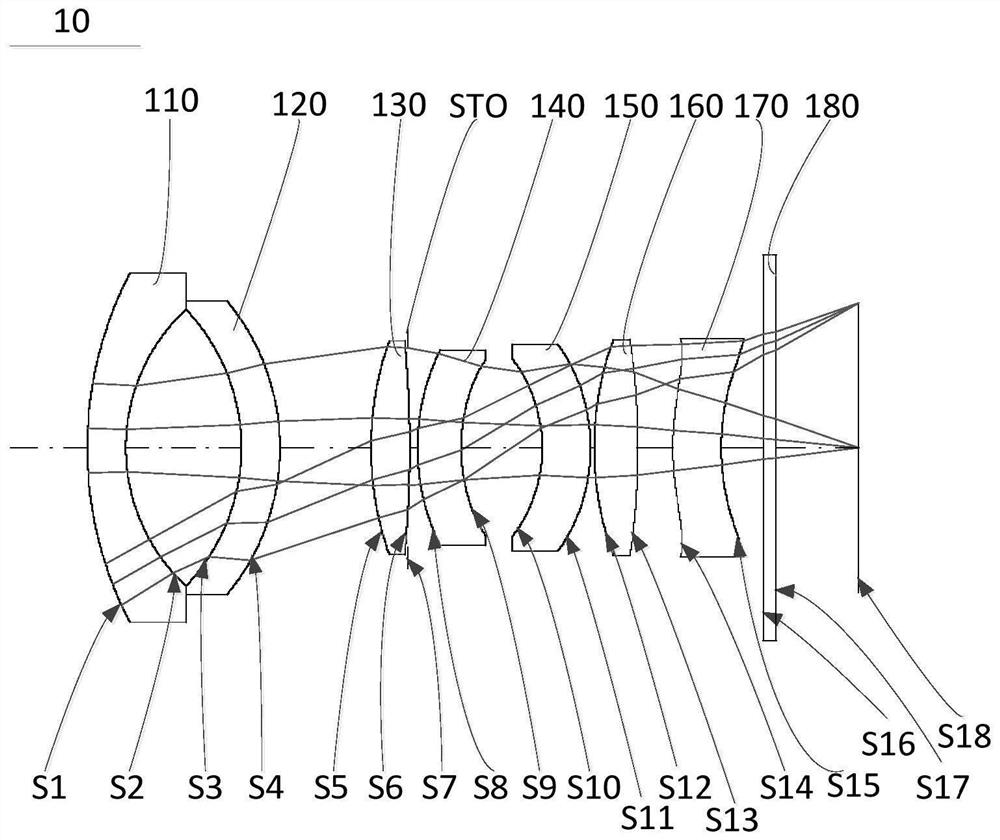Optical system, camera module, electronic equipment and carrier
A technology of optical systems and electronic equipment, applied in the field of optical systems, can solve problems such as low imaging resolution and inability to meet people's use needs
- Summary
- Abstract
- Description
- Claims
- Application Information
AI Technical Summary
Problems solved by technology
Method used
Image
Examples
specific Embodiment 1
[0090] For a schematic structural view of the optical system 10 of the embodiment of the present application, see figure 1 , the optical system 10 includes a first lens 110, a second lens 120, a third lens 130, an aperture STO, a fourth lens 140, a fifth lens 150, and a sixth lens 160 arranged in sequence along the optical axis from the object side to the image side , the seventh lens 170 and the filter 180. The first lens 110 has a negative refractive power, the second lens 120 has a positive refractive power, the third lens 130 has a positive refractive power, the fourth lens 140 has a negative refractive power, the fifth lens 150 has a negative refractive power, and the sixth lens 160 has a negative refractive power. Positive refractive power, the seventh lens 170 has positive refractive power. The object side S1 of the first lens 110 is convex at the near optical axis, and the image side S2 of the first lens 110 is concave at the near optical axis. The object side S3 of ...
specific Embodiment 2
[0105] For a schematic structural view of the optical system 10 of the embodiment of the present application, see image 3 , the optical system 10 includes a first lens 110, a second lens 120, a third lens 130, an aperture STO, a fourth lens 140, a fifth lens 150, and a sixth lens 160 arranged in sequence along the optical axis from the object side to the image side , the seventh lens 170 and the filter 180. The first lens 110 has a negative refractive power, the second lens 120 has a negative refractive power, the third lens 130 has a positive refractive power, the fourth lens 140 has a positive refractive power, the fifth lens 150 has a negative refractive power, and the sixth lens 160 has a positive refractive power. Positive refractive power, the seventh lens 170 has negative refractive power. The object side S1 of the first lens 110 is convex at the near optical axis, and the image side S2 of the first lens 110 is concave at the near optical axis. The object side S3 of ...
specific Embodiment 3
[0120] For a schematic structural view of the optical system 10 of the embodiment of the present application, see Figure 5 , the optical system 10 includes a first lens 110, a second lens 120, a third lens 130, an aperture STO, a fourth lens 140, a fifth lens 150, and a sixth lens 160 arranged in sequence along the optical axis from the object side to the image side , the seventh lens 170 and the filter 180. The first lens 110 has a negative refractive power, the second lens 120 has a negative refractive power, the third lens 130 has a positive refractive power, the fourth lens 140 has a negative refractive power, the fifth lens 150 has a negative refractive power, and the sixth lens 160 has a negative refractive power. Positive refractive power, the seventh lens 170 has positive refractive power. The object side S1 of the first lens 110 is convex at the near optical axis, and the image side S2 of the first lens 110 is concave at the near optical axis. The object side S3 of...
PUM
 Login to View More
Login to View More Abstract
Description
Claims
Application Information
 Login to View More
Login to View More - R&D
- Intellectual Property
- Life Sciences
- Materials
- Tech Scout
- Unparalleled Data Quality
- Higher Quality Content
- 60% Fewer Hallucinations
Browse by: Latest US Patents, China's latest patents, Technical Efficacy Thesaurus, Application Domain, Technology Topic, Popular Technical Reports.
© 2025 PatSnap. All rights reserved.Legal|Privacy policy|Modern Slavery Act Transparency Statement|Sitemap|About US| Contact US: help@patsnap.com



